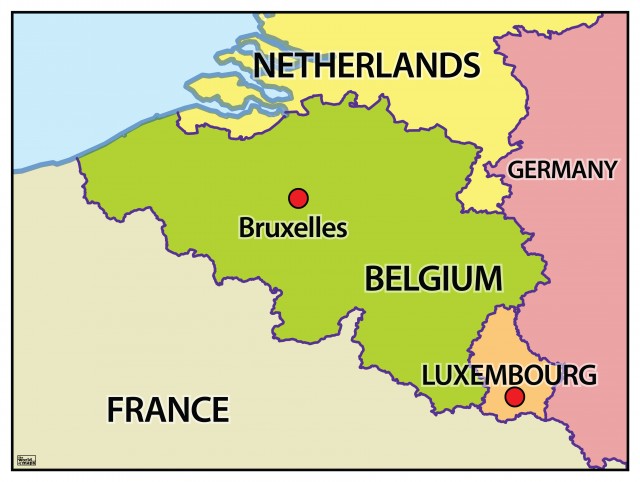Belgium
Area 11,790 square mi (30,510 square km)
Population 11.23 million 2014
Capital Brussels
Highest Point Signal de Botrange 2,290 ft (694 m)
Lowest Point 0 m
GDP $533.4 billion 2014
Primary Natural Resources coal, natural gas.
ALTHOUGH IT OCCUPIES a central position at the economic crossroads of western Europe, and its people have been central in the development of European society for over a thousand years, Belgium as a state has existed only since the early 19th century. The Belgian people share much of their culture with their Dutch neighbors to the north but have been deeply affected by proximity to northern FRANCE and by important transportation links to GERMANY in the east. The result is a nation that is both divided between French and Germanic culture and language, and a model for interethnic cooperation that provides an ideal setting for institutions such as the NORTH ATLANTIC TREATY ORGANIZATION (NATO) and the EUROPEAN UNION (EU).

Belgium is one of the three countries known as the Low Countries, which occupy the northwestern edge of the North European Plain. As the name indicates, most of the territory of these countries—Belgium, the NETHERLANDS and LUXEMBOURG—is flat and close to sea level. Much of the area adjacent to Belgium's 40-mi (66-km) North Sea coast is reclaimed land, protected from flooding by dikes and canals. The landscape becomes hillier in the central parts of Belgium and rises to low forested mountains in the southeast. This latter region is known as the Ardennes and is one of the largest areas of forest in western Europe. The Meuse River cuts its way through this wild part of the southeast, joined by its tributaries, the Sambre and the Ourthe, before passing into the Netherlands (as the Maas).
Further west, other large rivers cross Belgium, including the country's most important river, the Scheldet (Escaut in French), and its chief tributary, the Leie (Lys). But like the Meuse, the mouth of the Schelde is in the Netherlands, though the port city of Antwerp lies just a few kilometers inland. Antwerp is not only Belgium's most important port, it is the fourth-largest port in the world. Belgium's other port is Ostend, on the North Sea, connected to the Belgian interior via a series of canals. Other canals connect Antwerp to the Dutch ports of the lower Rhine, and the industrialized cities of the northwest to the mineral resources of the south and southeast.
The kingdom of Belgium is divided into 10 provinces: West Flanders, East Flanders, Antwerp, Flemish Brabant, Walloon Brabant, Hainaut, Namur, Limburg, Liege, and Luxembourg. Since 1993, it has also been divided into three regions—Flanders, the Brussels-Capital Region, and Wallonia—as well as three “communities,” one for each of the three official languages of the kingdom: Flemish, French, and German. These regions and communities roughly overlap but also have differences: The Brussels-Capital Region is an enclave within the Flemish-speaking region and is officially bilingual; the German-speaking population (less than 1 percent) live in several small towns close to the German border (the largest is Eupen). Flanders and Wallonia have roughly equal percentages of the land area, but Flanders has nearly twice as many people. This part of the country has one of the highest population densities in the world and includes some of Europe's most productive cities, including Bruges, Ghent and Antwerp. The French-speaking Walloon community is traditionally rural and less economically developed, resulting in some resentment that has threatened to break the country apart.
The unifying role of the monarchy and of the international position of Brussels as the “capital of Europe” goes a long way to ease this tension. As headquarters of NATO, the EU, and numerous other multinational corporations and organizations, Brussels has more resident foreigners (one in three), mostly diplomats and journalists, than any other city in Europe. It is estimated that about 23,000 “Eurocrats” live in Brussels. Immigrants from North Africa and TURKEY also make up a sizable percentage of the population. In the past, Brussels has been a center for heavy industry, linked to the coalfields of Hainaut, Namur and Luxembourg, one of the areas first affected by Europe's INDUSTRIAL REVOLUTION in the early 19th century.
Cities such as Mons, Charleroi, and Liege were built on coal but have suffered greatly since the shift away from coal as a primary fossil fuel in the late-20th century. The steel industry in this area is also being shut down, further accentuating the economic disparities between the French-speaking south and the successful economic engines of the Flemish-speaking north.
Flanders has long been a center of industry and prosperity; the soil in this area is sandy and relatively unproductive, so the local inhabitants turned to trade and manufacturing. Bruges lace and Ghent woolen cloth were famous as early as the 14th century.
Today, this region is a leader in biotechnology and petrochemicals, but also continues more traditional trade in textiles and diamonds (Antwerp is the diamond trading capital of the world). Wallonia is now being developed as a center for agricultural innovations. Traditional specialties from all across Belgium include over 350 varieties of beer and rich chocolates.